Serving 678 students in grades Kindergarten-5, Pinewood Elementary School ranks in the bottom 50% of all schools in Florida for overall test scores (math proficiency is bottom 50%, and reading proficiency is bottom 50%).
The percentage of students achieving proficiency in math is 40% (which is lower than the Florida state average of 52%). The percentage of students achieving proficiency in reading/language arts is 38% (which is lower than the Florida state average of 52%).
The student:teacher ratio of 14:1 is lower than the Florida state level of 17:1.
Minority enrollment is 65% of the student body (majority Hispanic), which is equal to the Florida state average of 65% (majority Hispanic).
Quick Stats (2025)
- Grades: Kindergarten-5
- Enrollment: 678 students
- Student:Teacher Ratio: 14:1
- Minority Enrollment: 65%
- Overall Testing Rank: Bottom 50% in FL
- Math Proficiency: 40% (Btm 50%)
- Reading Proficiency: 38% (Btm 50%)
- Science Proficiency: 35-39% (Btm 50%)
- Source: National Center for Education Statistics (NCES), FL Dept. of Education
School Overview
Pinewood Elementary School's student population of 678 students has declined by 13% over five school years.
The teacher population of 47 teachers has declined by 11% over five school years.
Grades Offered
Grades Kindergarten-5
Total Students
678 students
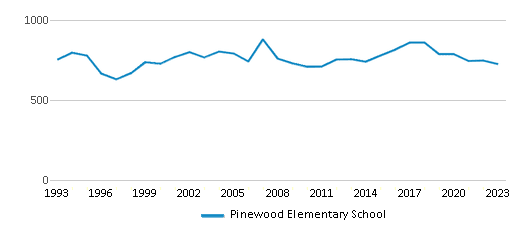
Gender %
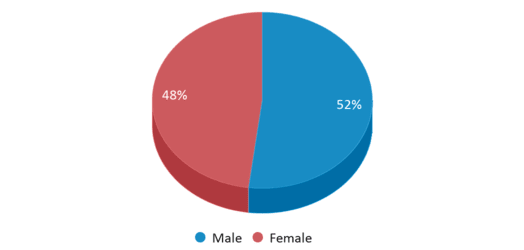
Total Classroom Teachers
47 teachers
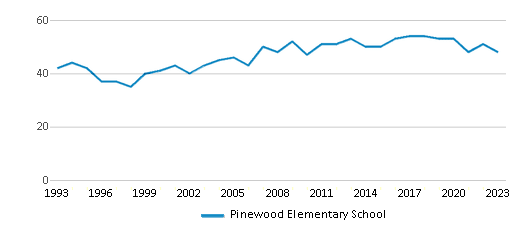
Students by Grade
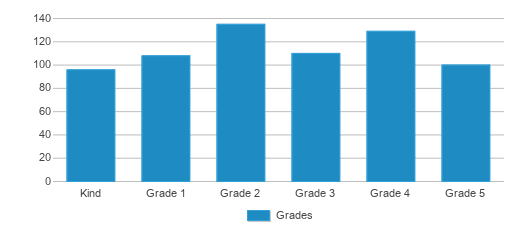
School Calendar
School Rankings
Pinewood Elementary School ranks within the bottom 50% of all 3,704 schools in Florida (based off of combined math and reading proficiency testing data).
The diversity score of Pinewood Elementary School is 0.62, which is less than the diversity score at state average of 0.70. The school's diversity has stayed relatively flat over five school years.
Overall Testing Rank
#2693 out of 3704 schools
(Bottom 50%)
(Bottom 50%)

Math Test Scores (% Proficient)
40%
52%
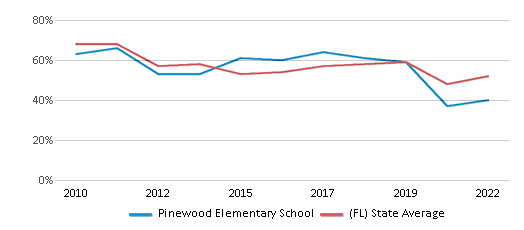
Reading/Language Arts Test Scores (% Proficient)
38%
52%
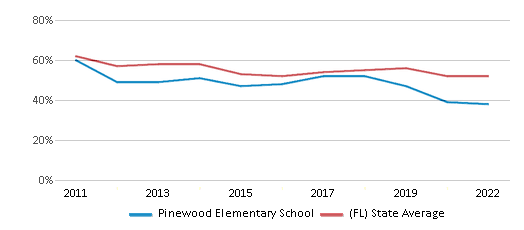
Science Test Scores (% Proficient)
35-39%
52%
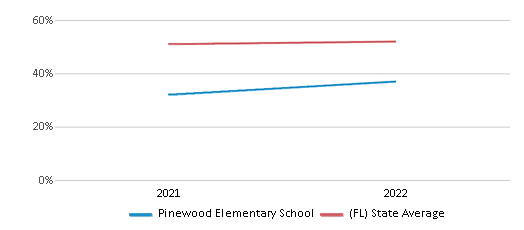
Student : Teacher Ratio
14:1
17:1
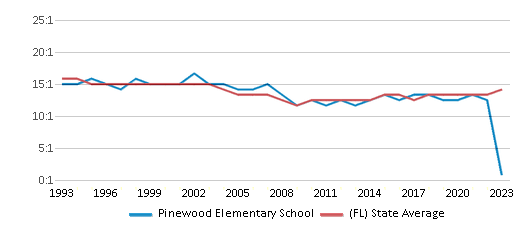
American Indian
n/a
n/a
Asian
2%
3%
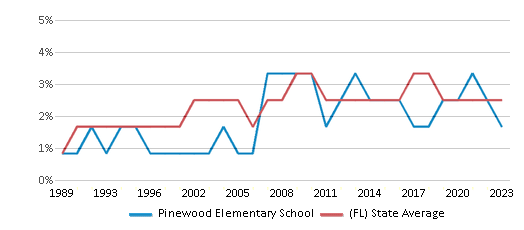
Hispanic
51%
37%
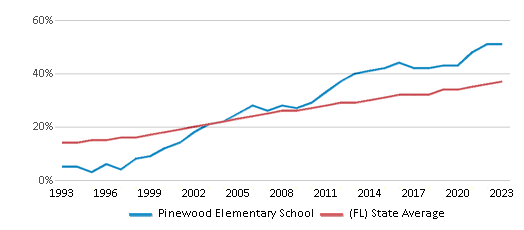
Black
7%
21%
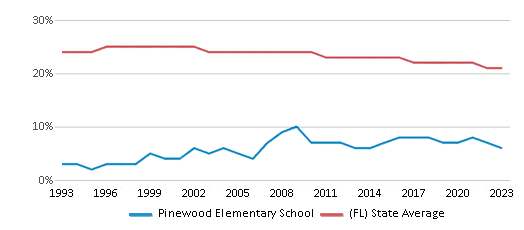
White
35%
35%
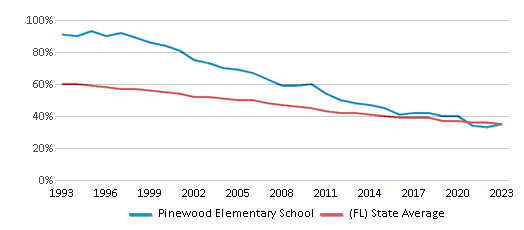
Hawaiian
n/a
n/a
Two or more races
5%
4%
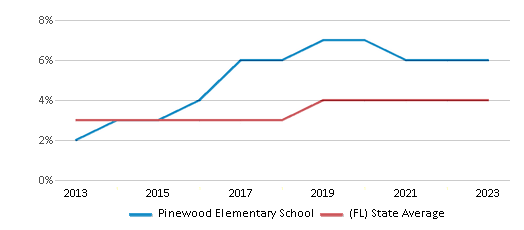
All Ethnic Groups
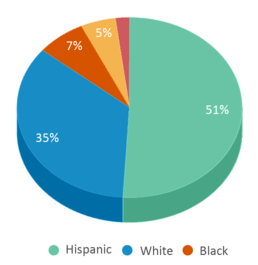

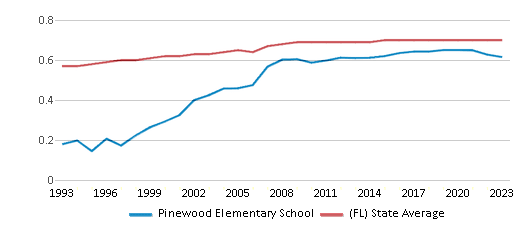
Participates in the National School Lunch Program (NSLP)
Yes
Eligible for Free Lunch
56%
47%
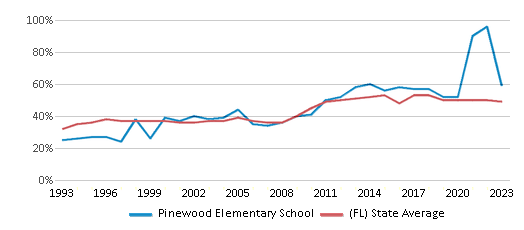
Eligible for Reduced Lunch
6%
4%

School Statewide Testing
School District Name
Source: National Center for Education Statistics (NCES), FL Dept. of Education
Profile last updated: 02/09/2025
Frequently Asked Questions
What is Pinewood Elementary School's ranking?
Pinewood Elementary School is ranked #2693 out of 3,704 schools, which ranks it among the bottom 50% of public schools in Florida.
What schools are Pinewood Elementary School often compared to?
Pinewood Elementary Schoolis often viewed alongside schools like Palm City Elementary School, Sea Wind Elementary School, Port Salerno Elementary School by visitors of our site.
What percent of students have achieved state testing proficiency in math and reading?
40% of students have achieved math proficiency (compared to the 52% FL state average), while 38% of students have achieved reading proficiency (compared to the 52% FL state average).
How many students attend Pinewood Elementary School?
678 students attend Pinewood Elementary School.
What is the racial composition of the student body?
51% of Pinewood Elementary School students are Hispanic, 35% of students are White, 7% of students are Black, 5% of students are Two or more races, and 2% of students are Asian.
What is the student:teacher ratio of Pinewood Elementary School?
Pinewood Elementary School has a student ration of 14:1, which is lower than the Florida state average of 17:1.
What grades does Pinewood Elementary School offer ?
Pinewood Elementary School offers enrollment in grades Kindergarten-5
What school district is Pinewood Elementary School part of?
Pinewood Elementary School is part of Martin School District.
School Reviews
4 2/25/2017
We moved here 4 yeas ago; at the end of my daughters first grade year. She will graduate from PWE this summer. There are not enough positive words I can say about how phenomenal the teachers are. Truly amazing. The main downfall of the school is the minority zoning. Majority of low income students speak English as a second language or come in as kindergarteners and don't speak English at all. Although I would put my children's education against any student in Martin county, I can't help but worry that the language is a distraction from all students learning.
2 3/19/2015
I'm very disappointed with this school, I used to have my daughter in a private school and big mistake when I change her to this school 2yrs ago, since then I notice a big change in the level of education and the system they use to teach the kids. I cannot wait to move from here to take her to another school. The system is awful, and now I think I have to pay for tutoring because she is behind compare with other schools. I'm so frustrated traying to help her at home every day. And talking to teachers does not help I think they don't care. I spoke to a couple of my friends they have their kids there and we think the same. So sad. :(
Review Pinewood Elementary School. Reviews should be a few sentences in length. Please include any comments on:
- Quality of academic programs, teachers, and facilities
- Availability of music, art, sports and other extracurricular activities
Recent Articles

What Is A Charter School?
Explore the world of charter schools in this comprehensive guide. Learn about their history, how they operate, and the pros and cons of this educational innovation. Discover key facts about charter schools, including admission policies, demographics, and funding, as well as what to look for when considering a charter school for your child.

10 Reasons Why High School Sports Benefit Students
Discover the 10 compelling reasons why high school sports are beneficial for students. This comprehensive article explores how athletics enhance academic performance, foster personal growth, and develop crucial life skills. From improved fitness and time management to leadership development and community representation, learn why participating in high school sports can be a game-changer for students' overall success and well-being.

February 05, 2025
Understanding the U.S. Department of Education: Structure, Impact, and EvolutionWe explore how the Department of Education shapes American education, from its cabinet-level leadership to its impact on millions of students, written for general audiences seeking clarity on this vital institution.





